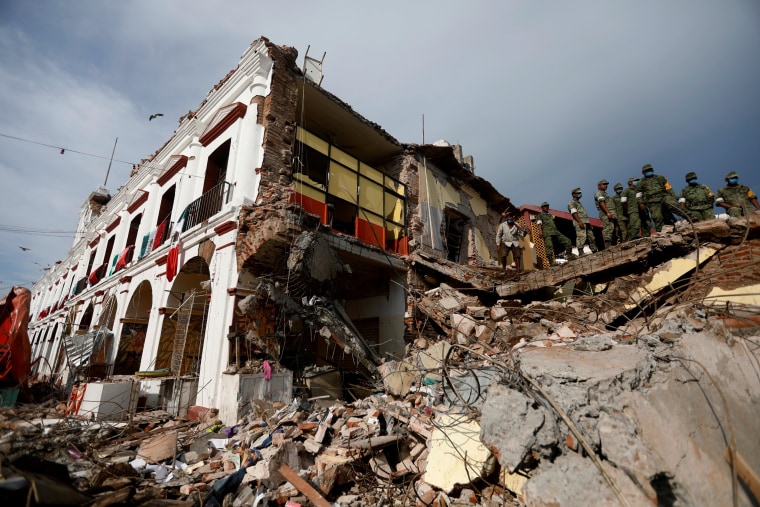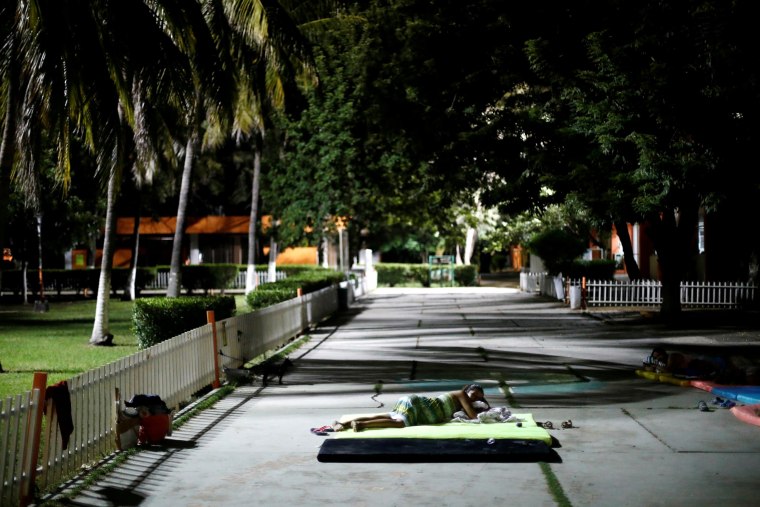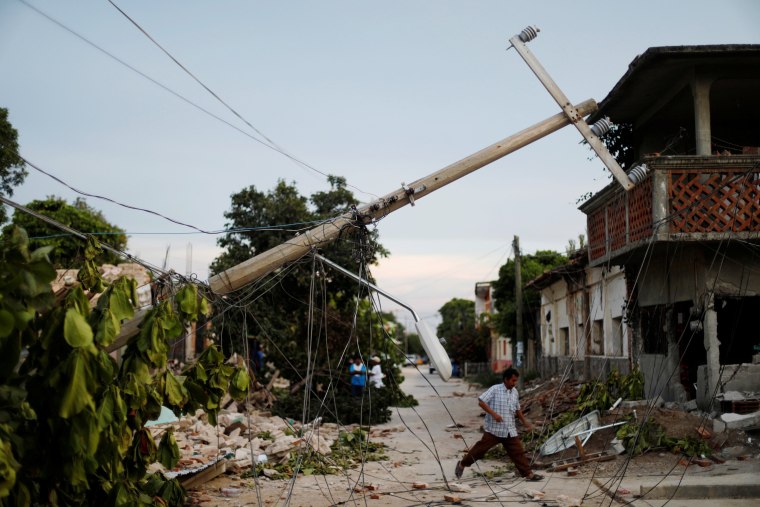JUCHITAN, Mexico — The death toll from one of the most powerful earthquakes ever recorded in Mexico rose to at least 61 early Saturday as workers scrambled to respond to the destruction just as Hurricane Katia struck its coastline.
The 8.1 quake off the southern Pacific coast just before midnight Thursday toppled hundreds of buildings in several states. Hardest-hit was Juchitan, Oaxaca, where 36 people died and a third of the city's homes collapsed or were otherwise rendered uninhabitable, President Enrique Pena Nieto said late Friday in an interview with the Televisa news network.
In downtown Juchitan, the remains of brick walls and clay tile roofs cluttered streets as families dragged mattresses onto sidewalks to spend a second anxious night sleeping outdoors. Some were newly homeless, while others feared further aftershocks could topple their cracked adobe dwellings.
"We are all collapsed, our homes and our people," said Rosa Elba Ortiz Santiago, 43, who sat with her teenage son and more than a dozen neighbors on an assortment of chairs. "We are used to earthquakes, but not of this magnitude."
Even as she spoke, across the country, Hurricane Katia was roaring onshore north of Tecolutla in Veracruz state, pelting the region with intense rains and winds.
The U.S. National Hurricane Center reported Katia's maximum sustained winds had dropped to 75 mph, making it a Category 1 storm when it made landfall. And it rapidly weakened even further over land into a tropical storm. The center said Katia was expected to dissipate over the course of Saturday.
But it was still expected to bring life-threatening floods and storm surge off the Gulf of Mexico, though the extent of the storm's impact was unclear in the dark of night.
Pena Nieto announced that the earthquake killed 45 people in Oaxaca state, 12 in Chiapas and 4 in Tabasco, and he declared three days of national mourning. The toll included 36 dead in Juchitan, located on the narrow waist of Oaxaca known as the Isthmus, where a hospital and about half the city hall also collapsed into rubble.
Rescuers searched for survivors Friday with sniffer dogs and used heavy machinery at the main square to pull rubble away from city hall, where a missing municipal police officer was believed to be inside.

The city's civil defense coordinator, Jose Antonio Marin Lopez, said similar searches had been going on all over the area since the previous night.
Teams found bodies in the rubble, but the highlight was pulling four people, including two children, alive from the completely collapsed Hotel Del Rio where one woman died.
"The priority continues to be the people," Marin said.
Pena Nieto said authorities were working to re-establish the supply of water and food and provide medical attention to those who need it. He vowed the government would help rebuild.
"The power of this earthquake was devastating, but we are certain that the power of unity, the power of solidarity and the power of shared responsibility will be greater," Pena Nieto said.
Power was cut at least briefly to more than 1.8 million people, and authorities closed schools in at least 11 states to check them for safety.
The Interior Department reported that 428 homes were destroyed and 1,700 were damaged in Chiapas alone.
"Homes made of clay tiles and wood collapsed," said Nataniel Hernandez, a human rights worker living in Tonala, Chiapas, who worried that inclement weather threatened to bring more structures down.
"Right now it is raining very hard in Tonala, and with the rains it gets much more complicated because the homes were left very weak, with cracks," Hernandez said by phone.
The earthquake also jolted the Mexican capital, which largely lies atop a former lakebed where the soil is known to amplify seismic waves. Memories are still fresh for many of a catastrophic quake that killed thousands and devastated large parts of the city in 1985.

The latest earthquake swayed buildings and monuments in the capital more than 650 miles from the epicenter.
Mexico City escaped major damage, though part of a bridge on a highway being built to the site of a planned new international airport collapsed due to the earthquake, local media reported.
The quake's power was equal to Mexico's strongest in the past century, and it was slightly stronger than the 1985 quake, the U.S. Geological Survey said.
However its impact was blunted somewhat by the fact that it struck some 100 miles offshore.
The quake triggered tsunami warnings and some high waves, but there was no major damage from the sea. Authorities briefly evacuated a few residents of coastal Tonala and Puerto Madero because of the warning.
